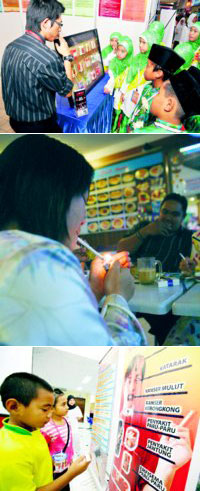
 April 8, 2010 - In Brunei (State of Brunei Darussalam or the Nation of Brunei), as elsewhere, smoking is not just a phenomenon connected with modern living; it has a cultural history as well. Before the influx of international brand cigarettes in the mid-twentieth century, smoking a Brunei “sigup”, or handmade cigarette, was considered a part of life here, while a smoke pipe, “pasigupan”, was a significant element in wedding ceremonies.
April 8, 2010 - In Brunei (State of Brunei Darussalam or the Nation of Brunei), as elsewhere, smoking is not just a phenomenon connected with modern living; it has a cultural history as well. Before the influx of international brand cigarettes in the mid-twentieth century, smoking a Brunei “sigup”, or handmade cigarette, was considered a part of life here, while a smoke pipe, “pasigupan”, was a significant element in wedding ceremonies.
Today, the habit has grown in prevalence and popularity with the ready availability of cheap cigarettes. But while smoking has been associated predominantly with male culture, current statistics show an increase in tobacco use amongst women and girls, both globally and locally.
According to an officer at the Tobacco Control Unit at the Ministry of Health, “male rates of smoking have peaked, while female rates are on the rise. Especially troubling is the rising prevalence of tobacco use among girls. Data from 151 countries shows that about 7 percent of adolescent girls smoke cigarettes as opposed to 12 per-cent of adolescent boys in some countries; almost as many girls smoke as boys. In Brunei, it was observed during routine enforcement that there is an increasing trend of smoking in women and girls”.
A report, “Smoking among Girls and Young Women in Asean Countries”, published in February 2009 by The Collaborative Funding Program for Southeast Asia Tobacco Control Research, claims “the single most important factor may be the rise in spending power among girls and women, which is making cigarettes more affordable. Social and cultural norms that have traditionally prevented women in many countries from smoking are weakening….and changes in women’s roles are associated with smoking uptake”. Second hand smoke, or passive smoking, also contributes to about 10-15 per-cent of the disease burden caused by active smoking, reports the World Health Organisation.
Beyond important measures of prevention in the public domain, how can children, who remain most vulnerable, be protected and dissuaded from taking up the habit?
The Ministry of Health has developed education programmes to communicate awareness of the harmful effects of smoking to school students, and roadshows include health talks and exhibitions on associated health consequences. Smoking cessation clinics, established since 2005, are also open to all age groups, including school students.
Dr Hj Faruque Reza at the Silver Jubilee Health Centre added that "parents are the role model for their children. If parents do not smoke, or quit smoking, children would stay away from smoking, provided parents create awareness among children about the harmful effects of smoking and benefits of not smoking".
The habit, however, can affect people at all ages. Dr Hj Faruque Reza sees prominent numbers of patients in the 30-40-year age group, as well as many girls around 18 years and women up to and over 55 years.
See reference to read entire article.
Health Warnings on Cigarette Packages: 2008-present..
Reference: Smoking top cause of cancer death in Brunei, Catherine Wilson,
BANDAR SERI BEGAWAN, The Brunei Times, 4/8/2010.
Related news briefs - Brunei..
Brunei - national tobacco control panel to create smoke-free society..;
Images: (Top) Students being briefed on the effects of smoking by an officer from the Health Education Promotion Unit. Picture: BT/Hj Mohd Ali; (Middle) Statistics reveal an increase in tobacco use amongst women and girls. Picture: BT/Zamri Zainal; (Above) Young children learning about the danger of smoking at an exhibition during the health programme for Mukim Kilanas, held at Bunut Health Centre, Kilanas. Picture: BT/Saifulizam... - Brunei Darussalam is a member of Southeast Asia Tobacco Control Alliance (SEATCA)..
- Brunei Darussalam is a member of Southeast Asia Tobacco Control Alliance (SEATCA)..
Bringing the World of Tobacco Control closer together..
Brunei - smoking top cause of cancer death
Subscribe to:
Post Comments (Atom)


To Provide Public Awareness
Purpose
About Us
Contact Us
2008 HIGHLIGHTS
TOPIX PAPERS - 2008 & 2009..
Archive
-
▼
2010 (1530)
-
▼
04/04 - 04/11 (40)
- Smoking may enhance link between existing risk fac...
- U.S. - State Cigarette Taxes Not Spent on Anti-Smo...
- Croatia - toughens anti-smoking measures..
- Smokers in ICU experiencing nicotine withdrawal..
- Malaysia - Health Ministry's proposal to ban the ...
- Canada - contraband cigarettes on the rise in West...
- CDC MMWR: State Cigarette Minimum Price Laws --- U...
- CDC MMWR: State Cigarette Excise Taxes --- United...
- Indonesia - parents encourage 4-year old boy to co...
- Reynolds Ameriacn q1 2010 financial results..
- Lorillard - q1 2010 earnings conference call..
- C-store owner Valero signs agreement to abide by m...
- Peter Jennings - in the U.S. lung cancer death rat...
- Smoking permanently banned on U.S. Navy submarines..
- Brunei - smoking top cause of cancer death
- Malaysia - increase in number of women smoking..
- India - cabinet decided to bar foreign direct inve...
- Viet Nam - WHO increase cigarette tax to lower sm...
- FDA CTP Update December 2009 - March 2010..
- Altria - webcast - 1st quarter 2010 results..
- Philip Morris Philippines..
- Great Forks, North Dakota - extends smoking ban to...
- Hemoglobin obtained from pigs may be used in ciga...
- Tobacco Control Legal Consortium: A “Commercial S...
- Israel - Knesset member bill eliminate nicotine fr...
- Philippines - DoH pushes for picture warnings on ...
- Rhode Island - bill before state senate to raise...
- New Hampshire - high school students smoking less ...
- Indonesia - government may raise cigarette tax and...
- Turkey - smoking ban compliance excellent and cig...
- Cambodia - may miss deadline to ban tobacco advert...
- Cambodia - agreement greater tobacco control measu...
- R.J. Reynolds submits information on Camel Dissolv...
- Massachusetts - jury rejects condo owner 's lawsu...
- Poland - attempt to introduce smoking ban in publ...
- Comments on the CBS News 60 Minutes story on smoke...
- PMI nominates Baidu CFO to board of directors..
- Guam - Video, increase in tobacco taxes takes effe...
- Seattle - parks limit smoking..
- Illinois - hopes to snuff out e-cigarette sales..
-
▼
04/04 - 04/11 (40)
© Copyright Notice: The content of this website is for information education purposes only and any newsbrief may be used only as "fair use" for information/education purposes with permission of the authors and providing that original references and associated reference links are included in HTML format.
0 comments:
Post a Comment